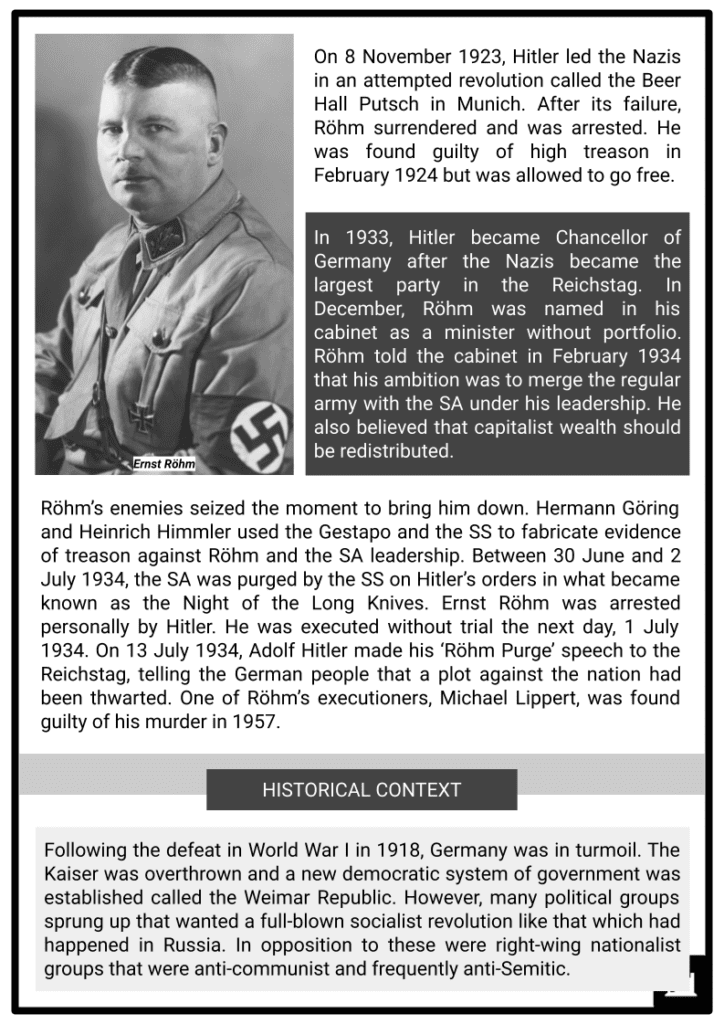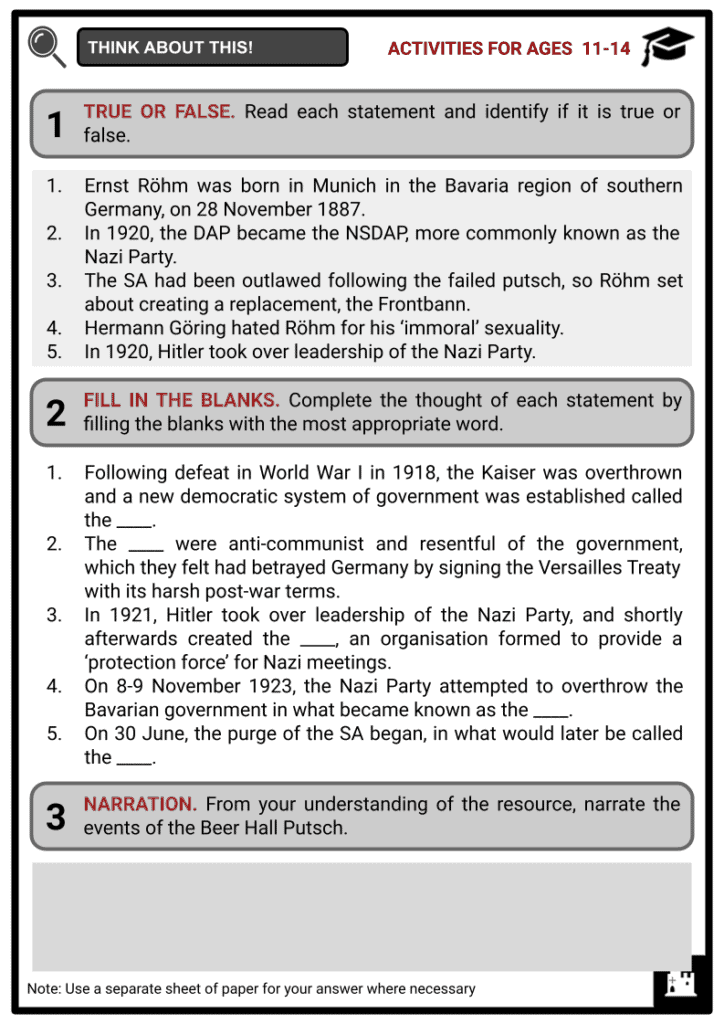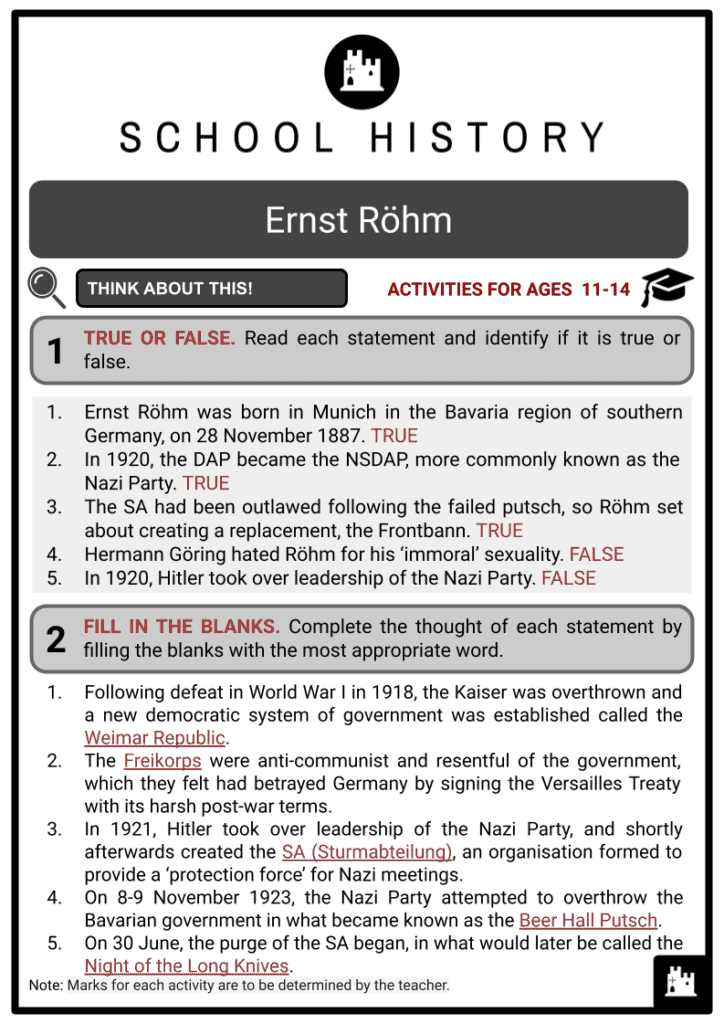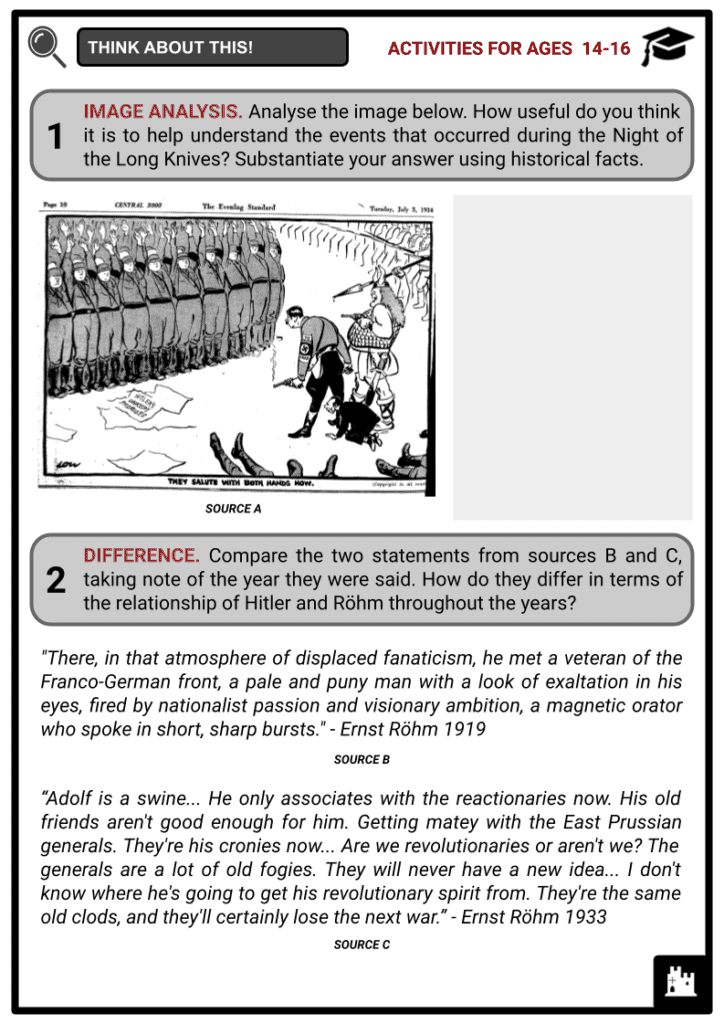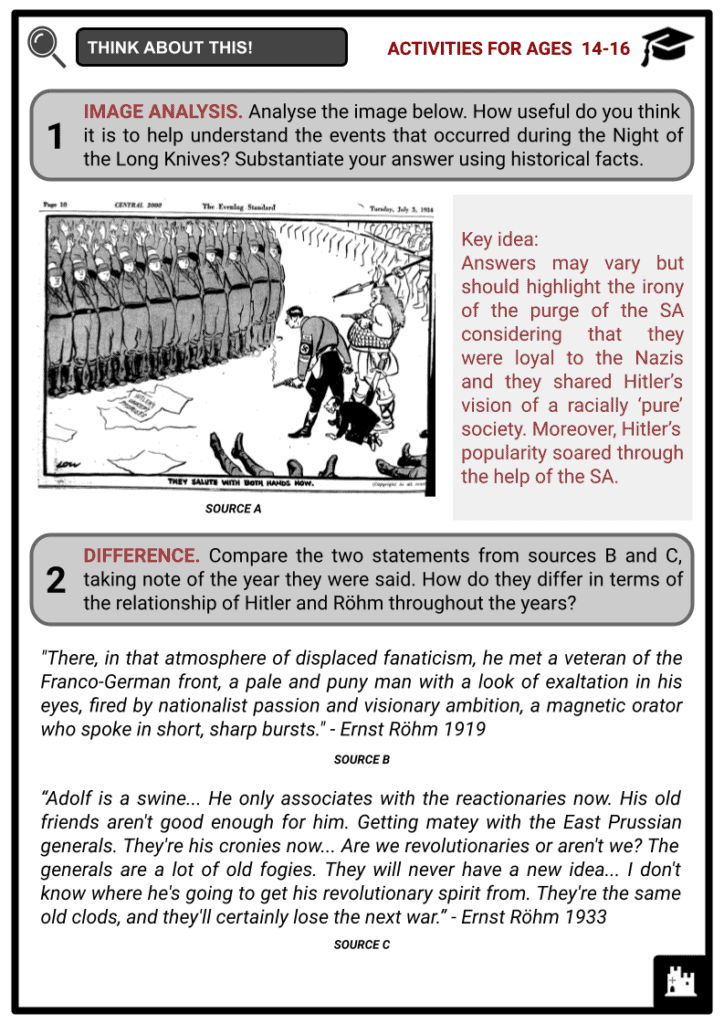Download Ernst Röhm Worksheets
Do you want to save dozens of hours in time? Get your evenings and weekends back? Be able to teach about the Ernst Röhmto your students?
Our worksheet bundle includes a fact file and printable worksheets and student activities. Perfect for both the classroom and homeschooling!
Table of Contents
Add a header to begin generating the table of contents
Summary
- Brief historical context of Germany after WWI
- Biography of Ernst Röhm
- Relationship with Adolf Hitler
- Röhm and the SA (Sturmabteilung)
- Beer Hall Putsch
- Röhm’s execution
Key Facts And Information
Let’s know more about Ernst Röhm!
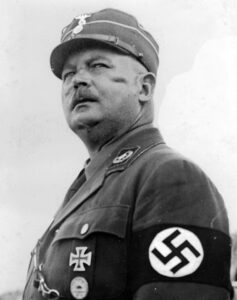
- Ernst Röhm was a member of the short-lived nationalist German Workers Party (DAP), where he met Adolf Hitler. He was able to use his army connections to finance the party. In February 1920, the DAP changed its name to the NSDAP, commonly known as the Nazi Party. Ernst Röhm was therefore one of the Party’s earliest members and a key link between the Party and the army.
- When Hitler became the leader of the Nazi Party in 1921, the SA (Sturmabteilung) was created to protect Party meetings and disrupt those of its opponents. Röhm was responsible for recruiting many of the SA members, and diverting weapons from the army for their use.
- On 8 November 1923, Hitler led the Nazis in an attempted revolution called the Beer Hall Putsch in Munich. After its failure, Röhm surrendered and was arrested. He was found guilty of high treason in February 1924 but was allowed to go free.
- In 1933, Hitler became Chancellor of Germany after the Nazis became the largest party in the Reichstag. In December, Röhm was named in his cabinet as a minister without portfolio. Röhm told the cabinet in February 1934 that his ambition was to merge the regular army with the SA under his leadership. He also believed that capitalist wealth should be redistributed.
- Röhm’s enemies seized the moment to bring him down. Hermann Göring and Heinrich Himmler used the Gestapo and the SS to fabricate evidence of treason against Röhm and the SA leadership. Between 30 June and 2 July 1934, the SA was purged by the SS on Hitler’s orders in what became known as the Night of the Long Knives. Ernst Röhm was arrested personally by Hitler. He was executed without trial the next day, 1 July 1934. On 13 July 1934, Adolf Hitler made his ‘Röhm Purge’ speech to the Reichstag, telling the German people that a plot against the nation had been thwarted. One of Röhm’s executioners, Michael Lippert, was found guilty of his murder in 1957.
HISTORICAL CONTEXT
- Following the defeat in World War I in 1918, Germany was in turmoil. The Kaiser was overthrown and a new democratic system of government was established called the Weimar Republic. However, many political groups sprung up that wanted a full-blown socialist revolution like that which had happened in Russia. In opposition to these were right-wing nationalist groups that were anti-communist and frequently anti-Semitic.
- Across Germany, paramilitary groups called Freikorps were formed, mostly from disaffected war veterans. The Freikorps were anti-communist and resentful of the government, which they felt had betrayed Germany by signing the Versailles Treaty with its harsh post-war terms.
- These turbulent times were the proving ground for the political group that would become known as the Nazi Party, and army captain Ernst Röhm was instrumental in the Party’s growth and Adolf Hitler’s rise to become its leader.
BIOGRAPHY OF ERNST RÖHM
- Ernst Röhm was born in Munich in the Bavaria region of southern Germany, on 28 November 1887. His beginnings were humble – his father was a railway official – and the young Ernst dreamed of becoming a soldier. He was able to realise his ambition in 1906, joining the Royal Bavarian Tenth Infantry Regiment.
- By the time of the outbreak of war in 1914, he had been promoted to an officer’s rank. Röhm was wounded three times in World War I, leaving him with noticeable facial scarring. The injuries he suffered at Verdun in 1916 ended his time in the war, although he recovered enough to be able to take on staff duties with his regiment. He was also awarded the Iron Cross First Class.
- Like many veterans, Röhm was angry at the terms of the peace that Germany signed at Versailles in 1919. The treaty limited the country’s army to 100,000 men and imposed punitive financial reparations. Röhm continued to serve in the army back in Munich, limited as it now was, and also joined a Freikorps unit.
- Munich was a particularly volatile city; a hotbed of revolution. Immediately after the end of the war, it was seized by a socialist faction and the Bavarian Soviet Republic was declared. Soon, a split within the leftist parties caused the collapse of the Republic, which was brutally put down with the help of the army and the Freikorps in May 1919. Ernst Röhm fought with the Freikorps at that time.
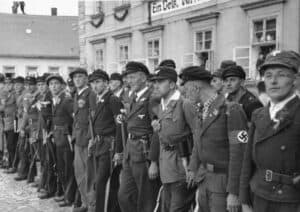
- As part of his army duties, Röhm was tasked with investigating political groups to find out if they posed a threat to the state. It was on one of these assignments that he encountered the German Workers’ Party (DAP), at a meeting where he met Adolf Hitler. The two hit it off, finding that they thought the same way when it came to their hatred of communism and the ‘traitors’ who had signed the Versailles Treaty. Röhm used his army contacts, as well as brutal violence where he deemed it necessary, to funnel illegal weapons to the DAP and its supporters, while Hitler’s gift for oratory made him an instant star of the organisation.
- As part of his army duties, Röhm was tasked with investigating political groups to find out if they posed a threat to the state. It was on one of these assignments that he encountered the German Workers’ Party (DAP), at a meeting where he met Adolf Hitler. The two hit it off, finding that they thought the same way when it came to their hatred of communism and the ‘traitors’ who had signed the Versailles Treaty. Röhm used his army contacts, as well as brutal violence where he deemed it necessary, to funnel illegal weapons to the DAP and its supporters, while Hitler’s gift for oratory made him an instant star of the organisation.
- In these chaotic days, Röhm was in effect creating his own army, training and arming disaffected men himself. The failed socialist governments in Bavaria gave rise to a horror of communism among many, which in turn made the region an ideal place for a right-wing coup.
- In 1920, the DAP became the National Socialist Workers’ Party (NSDAP), more commonly known as the Nazi Party. Its aim was to give more rights to workers, like socialism, but with a focus on German nationalism – only the ‘right’ sort of workers would benefit.
- In 1921, Hitler took over leadership of the Nazi Party, and shortly afterwards created the SA (Sturmabteilung). This organisation drew from Röhm’s Freikorps recruits and war veterans to provide a ‘protection force’ for Nazi meetings. The SA would also disrupt the meetings of rival organisations, especially communist groups.
- Soon Hitler and Röhm decided that the Nazi Party needed to take the next step and make a bid for power. Röhm resigned from the army so that he could focus entirely on the Nazi cause. On 8-9 November 1923, they attempted to overthrow the Bavarian government in what became known as the Beer Hall Putsch.
- Röhm’s part in the coup was to lead a band of 2,000 stormtroopers (specialist attack soldiers) to occupy the Ministry of War in Munich. This he managed successfully, but when the other Nazi units tried to link up with Röhm, a pitched battle with the police ensued and they were defeated. After 16 hours inside the building, Röhm surrendered and was arrested along with the rest of the Nazi leadership.
- Found guilty of high treason in February 1924, Röhm was nevertheless released on probation. With Adolf Hitler in jail, Röhm embarked on a brief political career, winning a seat in the Reichstag (parliament) in April 1924. He passionately believed that soldiers should take an active part in politics. However, he had lost his position as an elected official by the end of the year.
- The SA had been outlawed following the failed putsch, so Röhm set about creating a replacement, the Frontbann. After Hitler was released from prison, Röhm wanted to merge his Frontbann with the newly reformed SA. Hitler disagreed, and thus the first serious cracks in this political allegiance appeared. Röhm still believed that a revolution was needed to redistribute German wealth more evenly, but Hitler was moving away from this more left-wing policy. Röhm was removed as leader of the SA. In 1928, he took a job in Bolivia as an army consultant.
- However, Hitler was still unhappy with the role of the SA, which he believed was too independent from the main Nazi Party. Taking it under his own command, he asked Röhm to come back to Germany and run the SA again as its chief of staff. Röhm agreed, taking up his new role in January 1931.
- His return was not popular among the rest of the Nazi leadership: propaganda chief Joseph Goebbels hated Röhm for his ‘immoral’ sexuality, snobbish Hermann Göring despised his working-class roots, and SS chief Heinrich Himmler saw him as a rival for power. But he was one of Adolf Hitler’s most long-standing comrades, credited by the Führer with a crucial role in the rise of the Nazi Party. Hitler dismissed calls to sack Röhm for his well-known homosexuality, believing that his old friend still had a place in the upper echelons of the Nazis.
- For his part, Röhm was one of the very few who was not afraid of Hitler. They addressed each other using the informal German ‘Du’ (‘you’), and Röhm referred to Hitler as ‘Adolf’. But eventually Röhm crossed a line. His aim was to merge the SA, which was amassing millions of members in the early 1930s, with the regular army, under his command. Hitler could not allow this to happen – the regular army would never agree to it and he needed their support.
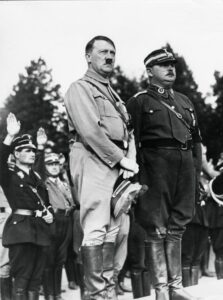
- Even after January 1933, when the Nazis’ election successes meant that Hitler was appointed Chancellor of Germany, his position was still dependent on the ageing President Hindenburg and the army. Röhm’s SA were causing chaos in the streets of Germany – it was what they had always done, but now Hitler needed to appear to be a regular politician in the eyes of the German population and the wider world. He reluctantly accepted that Röhm and the SA leadership had to go. Göring and Himmler lost no time in gathering a dossier of ‘evidence’ against Röhm, proving that he had been involved in a plot with France to launch a coup against Hitler.
- On 30 June the purge of the SA began, in what would later be called the Night of the Long Knives. Hitler had told Röhm to gather the SA leadership for a meeting in a Bavarian lakeside hotel. It was a trap. Early in the morning, Hitler, Goebbels and squads of SS men arrived at the hotel and started arresting SA officers. Some were shot immediately.
- Hitler personally arrested Ernst Röhm, who was so shocked he could barely respond. Röhm was taken to Stadelheim Prison in Munich. On Hitler’s orders, he was given the option of suicide with a pistol, but when the SS officers in charge of the execution returned to his cell, they found him waiting, standing with chest puffed out. “Let Adolf do it himself,” he said, and the two SS officers shot him dead. Many years later, in 1957, one of the officers responsible was jailed for Röhm’s murder.
- Although the SA continued to exist after the Night of the Long Knives, its power was much reduced. The Nazis used retroactive legislation to legalise the dozens and possible hundreds of killings carried out between 30 June and 2 July 1934, not just among the SA but many other opponents of the Nazi regime. Generally, the German people accepted Hitler’s story of the ‘Röhm Putsch’, an attempted coup from which the Führer himself claimed to have heroically saved Germany.
Image Sources
- https://upload.wikimedia.org/wikipedia/commons/0/02/Bundesarchiv_Bild_102-15282A%2C_Ernst_R%C3%B6hm_%28cropped%29.jpg
- https://img.haarets.co.il/img/1.6869813/3061228967.jpg
- https://upload.wikimedia.org/wikipedia/commons/b/b5/Bundesarchiv_Bild_146-1972-026-51%2C_Anschluss_sudetendeutscher_Gebiete.jpg


